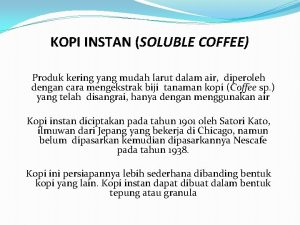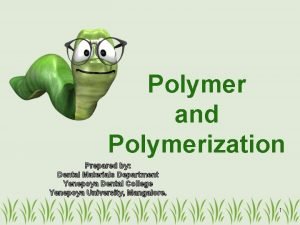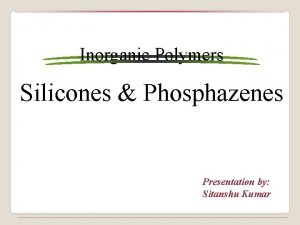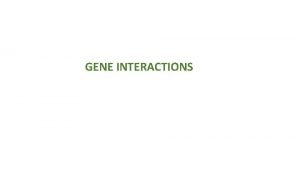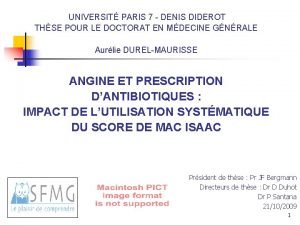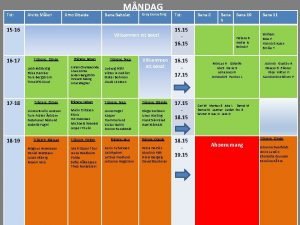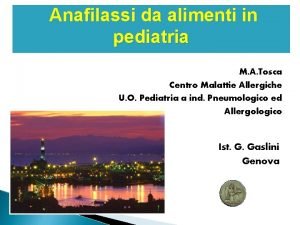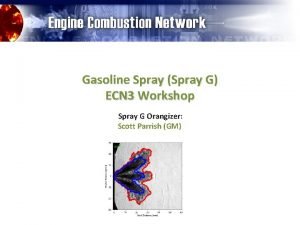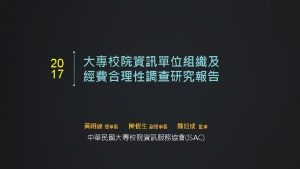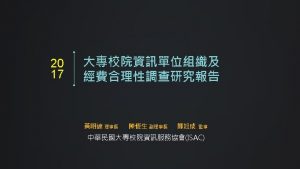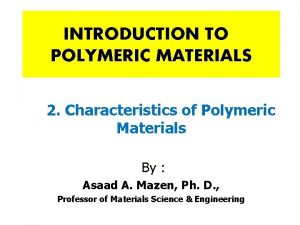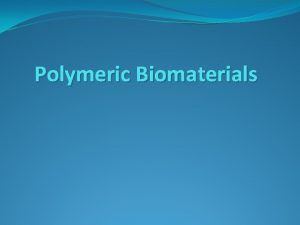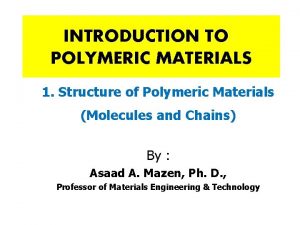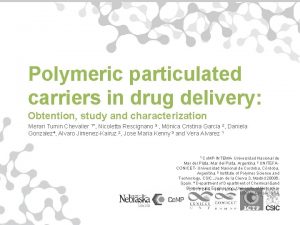ISAC CASE STUDY SPRAY DRIED DRUG LOADED POLYMERIC












- Slides: 12

ISAC CASE STUDY SPRAY DRIED DRUG LOADED POLYMERIC MICROPARTICLES ISAC_CS_01

Spray Dried Drug Loaded Polymeric Microparticles An Atomic Force Microscopy (AFM) Case Study

POLYMERIC MICROSPHERES FOR DRUG DELIVERY o Spray-dried polymeric microspheres have been investigated for use as a controlled release vehicle for active pharmaceutical ingredient (API) administration by intramuscular injection. o Combinations of biocompatible polymers can be deployed to balance a targeted release profile with appropriate API solubility and stability in-formulation. o One such example is a API/PLGA/PVP system (Meeus et al, 2012). o The surface characterisation of such systems is crucial in understanding how composition and environment affect physiochemical character and performance.

SURFACE CHARACTERISATION METHODS X-Ray Photoelectron Spectroscopy (XPS) • • Elemental Composition Chemical State Information Sputter Time-of-Flight Secondary Ion Mass Spectrometry (To. F-SIMS) • Depth Profiling (layer-by-layer chemistry). (200× 200µm 2) Scanning Electron Microscopy (SEM) • High magnification and resolution morphological and topographical characterisation PLGA - Green PVP - Red

LIMITATIONS o X-Ray Photoelectron Spectroscopy (XPS) can quantify the elemental composition of the particle surfaces and provide information on the chemical state. o Time-of-Flight-Secondary Ion Mass Spectrometry (To. F-SIMS) can qualify the chemical composition and characterise fine changes on a nanometer resolution with depth. Ø BUT these techniques cannot resolve the surface of an individual microparticle (size range <10µm) o Imaging with Scanning Electron Microscopy (SEM) provides visualisation on this scale. Ø BUT offers no distinction of chemical constituents o None of these techniques make no mechanical assessment of the microspheres

ATOMIC FORCE MICROSCOPY o Atomic Force Microscopy (AFM) is a high resolution scanning probe technique that allows visualisation of material surfaces and their topographical features with nanometre resolution, in addition to enabling surface physicochemical, mechanical, thermal or electrical properties to be measured. SEM Image AFM 3 D Profile Surface Characterisation down to the Nanoscale

NANOSCALE VISUALISATION o AFM can identify the morphological differences between sample surfaces such as microsphere formulation variants. API/PLGA/PVP Microspheres 10/75/15 (%wt) 20/50/30 (%wt) Homogeneity Morphology Uniformity Form, shape, structure Observe changes between formulations 30/25/45 (%wt) Topography Distribution of features

NANOMECHANICAL MAPPING o AFM offers the capacity to generate simultaneous ‘multi-channel’ data. o Sample topography can be complemented by simultaneous mapping and quantification of mechanical data including adhesion, stiffness etc. Different Materials e. g. API / PLGA Surface Depression Microparticle Topography Microparticle Stiffness o Topographical variability distinguished from material differences i. e. API from polymer domains.

‘IN-SITU’ REAL TIME ANALYSIS o AFM allows observation of physical and chemical responses at the surface to formulation parameters, and real-time changes to the environment etc. Height Phase E. g. AFM can characterise the surface rearrangement of constituent polymers Humidity 10% due to a humidity increase. Rearrangement and phase separation seen Humidity 80% at the sample surface. 5µm x 5µm PLGA/PVP 40/60 wt

SUMMARY o AFM is an invaluable tool in the characterisation of the surfaces of micro- and nano-scale materials such as single spray dried polymeric microparticle formulations o Nanomechanical data identified measurable phase differences representative of distinct API and polymer domains not resolved by other characterisation methods. o Real-time, ‘in-situ’ changes to single particle surfaces in response to environment observed. o AFM offers a unique capacity to complement broader chemical and visual analysis with nanometre resolution topographical, and simultaneous mechanical characterisation. o Insight from AFM develops understanding of formulation dynamics and responses that can be linked to performance and used in development

REFERENCES For more details on the work showcased in this case study see the following publications: Nanoscale Surface Characterization and Miscibility Study of a Spray-Dried Injectable Polymeric Matrix Consisting of Poly(lacticco-glycolic acid) and Polyvinylpyrrolidone. Joke Meeus, Xinyong Chen, David J. Scurr, Valeria Ciarnelli, Katie Amssoms, Clive J. Roberts, Martyn C. Davies, Guy Van Den Mooter. Journal of Pharm. Sci. , 2012, 101, (9) 3473 -3485 Surface Characteristics of Spray-Dried Microspheres Consisting of PLGA and PVP: Relating the Influence of Heat and Humidity to the Thermal Characteristics of These Polymers. Joke Meeus, David J. Scurr, Katie Amssoms, Martyn C. Davies, Clive J. Roberts and Guy Van den Mooter. Mol. Pharmaceutics 2013, 10, 3213− 3224

ADDITIONAL INFORMATION • If you wish to get in touch with us to discuss the information provided, raise a query/concern or provide feedback then please feel free to get in touch via any of the methods listed below: The Interface and Surface Analysis Centre (ISAC) Boots Science Building (C 08) University Park Nottingham NG 7 2 RD Telephone: +44(0)115 951 5046 / +44(0)115 645 3130 Email: isac@nottingham. ac. uk Fax: +44 (0)115 846 7969 Website: www. nottingham. ac. uk/isac
